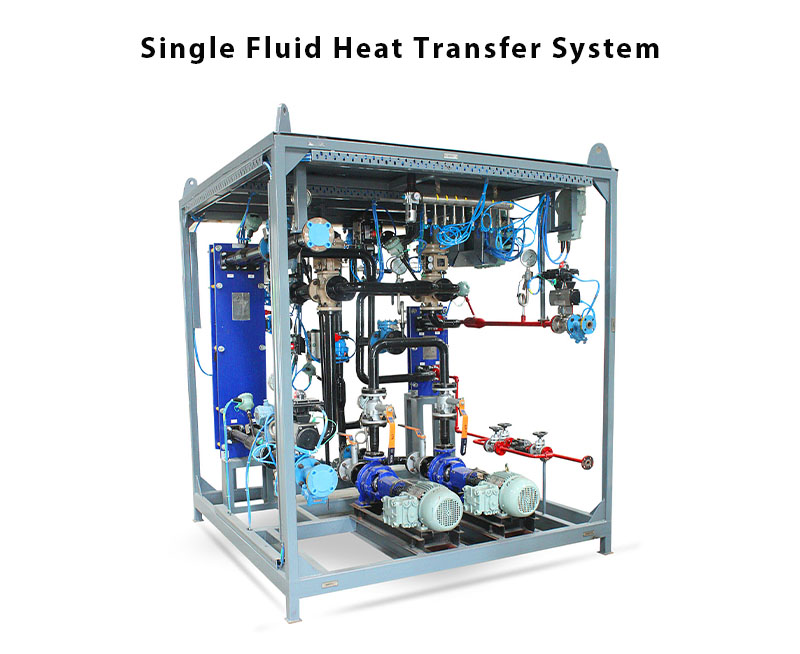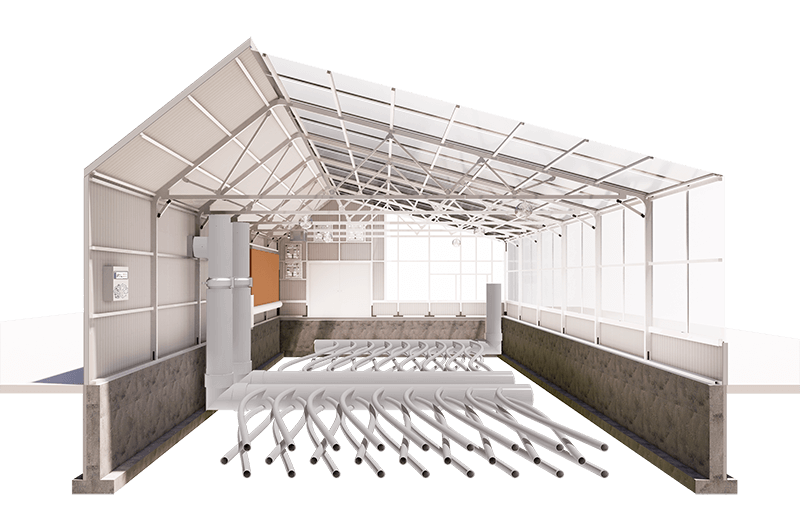How DVS Heat Transfer Systems Utilize Graphene and Nanofluids to Maximize Thermal Conductivity
Wiki Article
The Duty of Heat Transfer Solutions in Sustainable Energy Solutions for the Future
Heat transfer systems are essential in the pursuit for lasting power options. They enhance thermal energy monitoring, enhancing the effectiveness of renewable technologies. By using systems like conduction, radiation, and convection, these systems decrease energy losses. Their role in solar thermal and geothermal applications is particularly substantial. As advancements emerge, the potential for further innovations increases important inquiries regarding future power methods. What growths will shape the landscape of lasting energy?Recognizing Heat Transfer Systems

The Relevance of Thermal Power Management
Effective thermal power administration is crucial for optimizing energy performance and reducing waste in different systems. By managing temperature and maximizing Heat transfer procedures, organizations can substantially decrease energy consumption and functional costs. Efficient administration entails the execution of innovative innovations and techniques that check and manage thermal problems within systems, making certain that energy resources are utilized successfully. Additionally, correct thermal power management adds to lowering greenhouse gas emissions, aligning with global sustainability objectives. It also improves system reliability and efficiency, resulting in improved item high quality and longer equipment life expectancy. Eventually, focusing on thermal power monitoring is an important action towards producing more lasting power options and cultivating a responsible approach to power usage in residential and commercial contexts.Applications of Heat Transfer in Renewable Resource
While various sustainable power sources promise sustainability, the reliable application of Heat transfer plays an essential function in their efficiency. In wind energy systems, Heat transfer is utilized for generator part air conditioning, boosting efficiency and longevity. Geothermal energy relies upon effective Heat exchange between the earth's subsurface and the fluid distributing in the system, making best use of power removal. Biomass power processes also gain from Heat transfer, as it aids in transforming organic products right into functional fuel with pyrolysis and gasification. Additionally, in hydropower, preserving ideal temperature levels in reservoirs can boost power output. Each of these applications shows the vital significance of Heat transfer systems in improving renewable resource modern technologies, inevitably adding to a much more sustainable energy future.Enhancing Solar Thermal Power Performance
As solar thermal power systems remain to evolve, improving their performance has actually become necessary for taking full advantage of power result. Developments in Heat transfer innovations, such as enhanced thermal storage space materials and cutting-edge Heat exchangers, play a significant duty in improving efficiency. By utilizing advanced materials that have remarkable thermal conductivity, systems can catch and move Heat better. Furthermore, integrating tracking systems that comply with the sunlight's course guarantees that enthusiasts receive excellent solar direct exposure throughout the day. Using nanotechnology in solar absorbers can additionally increase energy absorption rates. Including automated control systems helps regulate temperature levels and take care of energy distribution effectively, leading to decreased losses and enhanced total system efficiency. These enhancements lead the way for more sustainable solar thermal energy options in the future.Geothermal Home Heating: A Lasting Solution
Geothermal home heating provides a feasible choice for lasting energy, providing substantial environmental advantages through reduced greenhouse gas exhausts. Its performance and cost-effectiveness make it an eye-catching option to typical furnace. Difficulties related to execution needs to be dealt with to maximize its possible impact.Environmental Benefits of Geothermal
Standard home heating approaches contribute substantially to greenhouse gas discharges, geothermal home heating provides a compelling choice that lessens environmental influence. By using the Earth's interior Heat, geothermal systems make use of an eco-friendly energy source, markedly decreasing dependence on nonrenewable fuel sources. This method produces minimal carbon exhausts, making it a cleaner choice for residential and business heating. In addition, geothermal systems promote power performance, as they require less energy compared to traditional heating unit. DVS Heat Transfer Systems. The application of geothermal energy also aids in reducing air pollution, improving regional air top quality and public health. As a lasting option, geothermal home heating sustains environment modification mitigation efforts, positioning itself as a necessary part in the change in the direction of a greener futureEffectiveness and Cost-Effectiveness
How does geothermal heating measure up in regards to performance and cost-effectiveness contrasted to typical furnace? Geothermal home heating shows remarkable effectiveness, usually attaining a coefficient of efficiency (POLICE OFFICER) of 3 to 5, meaning it generates three to 5 devices of Heat for every single device of electrical power consumed. This performance equates into lower operating costs, specifically in regions with secure geothermal sources. Preliminary setup expenses can be more than conventional systems; nonetheless, long-lasting cost savings on power costs and lowered maintenance expenses can counter these in advance investments. In addition, lots of federal governments incentivize geothermal systems through discounts and tax obligation credit scores, improving their check out this site cost-effectiveness. Overall, geothermal home heating becomes a lasting and financially viable alternative to even more conventional home heating remedies.Implementation Challenges and Solutions
Numerous obstacles can hinder the widespread execution of geothermal heating systems, regardless of their clear advantages as a lasting power solution. High first installation expenses frequently prevent capitalists and house owners, making financing a considerable obstacle. Additionally, the geographical restrictions of ideal geothermal sites restrict access in specific areas. Neighborhood policies and allowing procedures can also make complex project advancement, bring about delays. Public recognition and understanding of geothermal systems remain low, preventing acceptance. To deal with these obstacles, targeted education campaigns can improve public understanding, while federal government motivations can reduce monetary problems. Teaming up with regional authorities to streamline regulations may help with smoother project approvals, ultimately promoting the adoption of geothermal heating as a feasible, sustainable energy option.Developments in Heat Transfer Technologies
Technologies in Heat transfer modern technologies play a crucial role in improving energy performance and sustainability. Advanced Heat exchangers and phase adjustment products go to the leading edge of these advancements, providing significant improvements in thermal monitoring. These technologies not only maximize power usage but additionally add to lowering ecological effect in different applications.Advanced Heat Exchangers
Advanced Heat exchangers play a necessary function in improving energy efficiency throughout various applications in lasting power services. These devices facilitate the transfer of Heat between 2 or more fluids, significantly decreasing energy usage in processes such as commercial heating, air conditioning, and power generation. Developments in products and style, such as using nanofluids and small configurations, have actually resulted in improved thermal performance and reduced size needs. Furthermore, advancements in digital monitoring and control systems enable for maximized operation, more enhancing performance. By reducing waste Heat and making the most of power recovery, progressed Heat exchangers add to reduce carbon impacts and sustain the shift toward eco-friendly innovations. Their proceeded growth is important for attaining worldwide energy sustainability objectives.
Phase Change Materials
The integration of stage adjustment products (PCMs) right into Heat transfer technologies stands for a substantial innovation in energy administration and performance. PCMs soak up and release thermal energy during their stage adjustments, making it possible for efficient temperature level law in building materials and power systems. By keeping excess Heat throughout peak durations and launching it when demand increases, PCMs add to fill changing and power preservation - DVS Heat Transfer Systems. This capability improves the efficiency of renewable resource systems, specifically in solar thermal applications. In addition, PCMs can boost the thermal convenience of indoor atmospheres, lowering dependence on traditional home heating and cooling methods. As developments in PCM formulations proceed to arise, their function in lasting power remedies is poised to expand, offering appealing avenues for future study and application
Future Leads for Heat Transfer in Sustainable Power
As the demand for sustainable power solutions remains to increase, the function of Heat transfer systems is coming to be significantly crucial in forming future innovations. Advancements in materials and styles are anticipated to boost effectiveness in Heat transfer, reducing energy losses in various applications. The assimilation of sophisticated thermal storage systems, such as stage adjustment products and thermochemical storage space, will certainly enable better administration of energy resources. Study right into nanofluids and biomimetic Heat exchangers might further maximize thermal efficiency. The fostering of clever innovations will allow for real-time tracking and flexible control of Heat transfer processes. These advancements are poised to substantially add to the total effectiveness and sustainability of energy systems, paving the method for a much more energy-efficient future.Frequently Asked Inquiries
Exactly How Can Individuals Implement Heat Transfer Systems in your home?

Individuals can carry out Heat transfer systems in the house by mounting energy-efficient devices, making use of glowing home heating, and optimizing insulation. These actions enhance energy effectiveness, lower prices, and promote lasting techniques in residential environments.

What Are the Prices Connected With Setting Up Heat Transfer Systems?
The costs connected with mounting Heat transfer explanation systems differ commonly, generally incorporating tools, installation labor, and maintenance. Elements such as system kind, home dimension, and regional guidelines greatly influence the general expense entailed.Exist Government Motivations for Heat Transfer System Installations?
Government motivations for Heat transfer system installments vary by region and can consist more info here of tax obligation grants, rebates, and credit ratings. These financial advantages aim to encourage fostering, eventually advertising energy efficiency and reducing ecological impact within areas.Exactly How Do Heat Transfer Equipments Impact Power Bills?
Heat transfer systems especially influence power expenses by maximizing energy efficiency. By enhancing the transfer of Heat, these systems minimize energy usage, leading to reduced energy expenses and developing a more sustainable approach to energy monitoring.What Maintenance Is Needed for Heat Transfer Solutions?
Maintenance for Heat transfer systems includes normal assessments, cleansing of components, examining fluid levels, making certain correct insulation, and changing used parts. These tasks assist preserve effectiveness, protect against malfunctions, and extend the system's functional lifespan.These systems assist in the motion of thermal power from one tool to another, allowing the transfer of Heat for power, home heating, or air conditioning generation functions. Geothermal power counts on effective Heat exchange between the planet's subsurface and the liquid flowing in the system, taking full advantage of power removal. In addition, geothermal systems advertise power efficiency, as they require less energy compared to traditional heating systems. Advanced Heat exchangers play a crucial duty in enhancing power effectiveness across various applications in lasting power options. Heat transfer systems especially affect energy expenses by optimizing power performance.
Report this wiki page